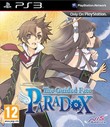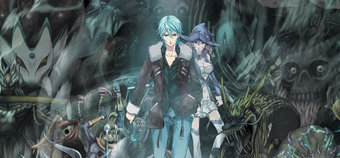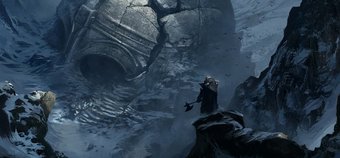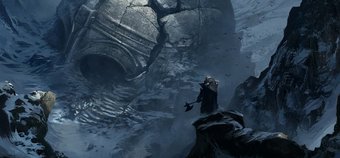Recruitment in the heavenly land of Celestia is a... tad unusual to say the least. After a spin of the honourable lottery machine of destiny, unsuspecting and chronically unlucky high-schooler Renya Kagurazaka nets himself the grand prize - the chance to become God. Whisked away to the heavens and tasked with answering the prayers of everyone, from a broken hearted Mermaid intent on revenge, to a zombie terrified of the very humans he needs to hunt, to a depressed Cinderella, fed up with the monotony of fairytale life, your day to day life will never be the same again. But what's perhaps the strangest of settings for a dungeon crawler is what makes The Guided Fate Paradox really shine - it's a nonsensically cute tale that doesn't take itself too seriously, with a solid game attached.
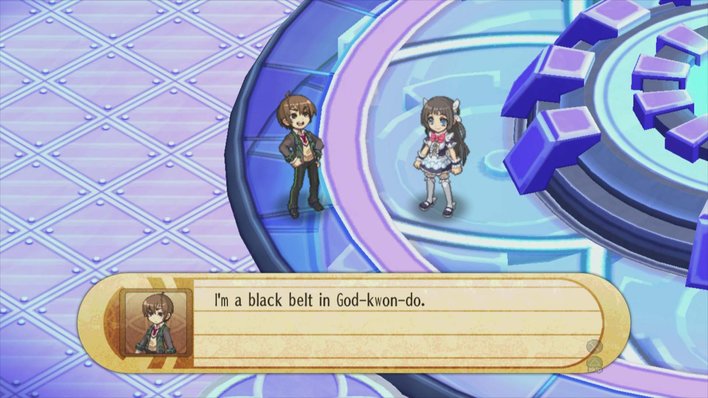
Cocky, much?
But granting wishes as a newly ordained phenomenal cosmic power isn't as easy as simply waving a magic wand - with the help of Celestia's crazy cast of angels and the high tech Fate Revolution Circuit machine, you'll need to do some serious legwork first. The aforementioned Fate Revolution Circuit is, in a nutshell, where your Godly magic happens - a serious bit of kit that copies reality, and then creates a portal to this simulated 'Copy World', it's up to you to step through and defeat the monsters held within, known as aberrations, which inhabit the floors of the randomly generated dungeons it creates. These aberrations are what stands between you and granting your subjects' prayers, each one trying to resist your interference in that person's fate, as you make your way from floor to floor, heading ever closer to the final boss fight which marks the end of each chapter.
Traipsing through the dungeons, a slow and considered approach is generally for the best - and not just because the dungeons are at a 45 degree angle, and consequently forward on the d-pad isn't necessarily forward in the game. For starters, when inside the Fate Revolution Circuit, every move you make and every step you take depletes your finite energy meter, which needs to be topped up by chobbling on apples from time to time. As you move around each level, the aberrations that populate the dungeon floors will all move at the same time as you, meaning that if you stand still, they also stay put, giving you chance to think about your should do next. On the floor is a grid, and each enemy has a certain cone of vision, shown by the white squares around their feet - if you step inside their field of view, they'll start chasing you down. When engaging them in combat though, things switch around a bit, with you, your angel friend and each aberration taking it in turns to attack, unleash special moves or use various items (rather than moving at the same time) - and to add a touch of Disgaea-style craziness to the proceedings, certain scenery (as well as your angel accomplice and random items from your inventory) can be lifted and thrown at your enemies to deal damage too.
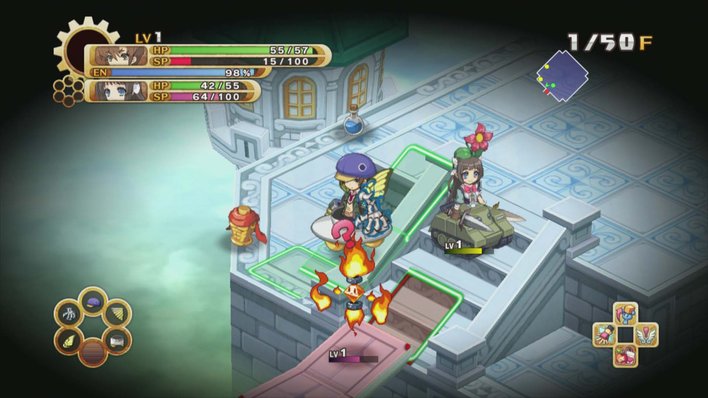
Just your average day in the Fate Revolution Circuit...
Like your typical role-playing game, each enemy you defeat earns you a certain amount of experience points, and once you've built up enough your overall level increases, making Renya more powerful. But while other games have a steady increase in your level as you play, The Guided Fate Paradox takes a bit of a different approach - every time you leave a dungeon, your level resets to 1. At least, the number does. While it may look as though you're back where you started from, any stat boosts you earnt by levelling up will stay with you - so while it may say you're level 1, you're technically a stronger level 1 character than you were before. It's a bit of a strange concept to get your head round, but we can assure you it's not as complicated as it sounds.
As you travel through the dungeons, you'll find all sorts of mental equipment to outfit your God and angels with - things that go far beyond the standard RPG fare of swords and shields. From tank tracks to zombie hands to a carrot on a stick, each item has it's own innate special ability or attack to try out. When you've used a certain sword (or whatever) enough, it'll enter a special 'burst' state, which causes it to temporarily drop in power - but also nets you a few bonuses. Bursting equipment can be taken to the upgrade shop and strengthened, ready to burst again (so you can continually make your favourites stronger), while your character will earns themselves a tile to place on the Divinigram - a novel method of body modification which lets you place pieces on a chess-like board to boost Renya's stats even further.
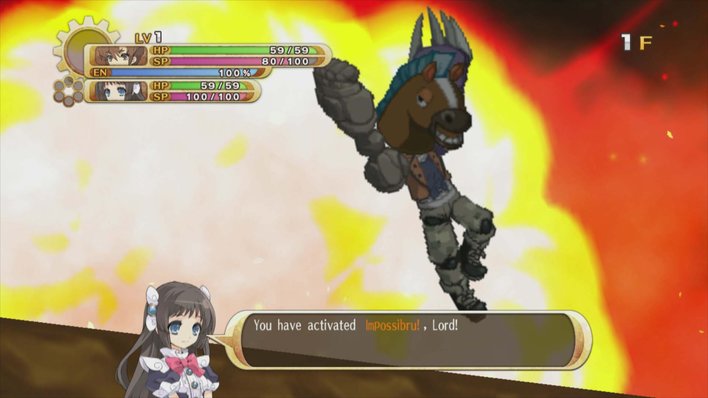
Changing equipment also changes your appearance...
While The Guided Fate Paradox is definitely a few steps away from being quite as finger blisteringly hard as your average dungeon crawler, it is still pretty unforgiving. When you die in one of the dungeons - and you will die, and fairly often too - you'll be respawned in Celestia, safe and sound, but with all the items that were stuffed in your bag having been lost during your resurrection. That means you have to wave goodbye to your sweet Prinny boat you've been dutifully strengthening up, that mushroom hat that doesn't really do much but looks awesome and the pistol you lovingly renamed 'The Shootinator', as death, it seems, can be a harsh mistress... Sometimes the game may take pity on you and give you an Exit item to teleport you out of a dungeon when you get into a fix, but more often than not we found ourselves dying and losing that too. Oh and did we mention that your money gets halved when you die, too? Yeah.
Failure, though, is a large part of the game in The Guided Fate Paradox, as even if you die, you'll keep any progress you made towards levelling your character up, making you stronger for your next attempt. Perhaps more important than any amount of levelling, though, is the incredible amount of luck involved in the levels you're facing. With stages being randomly generated, sometimes things can seem like they're not exactly stacked in your favour, particularly when you spawn in a room chock-a-block with monsters, heralded by a chirpy "ABERRATIONS OUT THE WAZOO!" from your angelic companion, before promptly getting overwhelmed and killed by a load of monsters you think really shouldn't be there.
While it's not the most forgiving game in existence, it's definitely worth persevering with The Guided Fate Paradox as the stories - both the self-contained tale of each prayer and the overarching main story - are well-written, entertaining and even thought-provoking at times, with plenty of pop culture references and a smattering of adult humour thrown in for good measure. If you like your games more than a bit crazy and rather Japanese, then you'll be right at home here.
Format Reviewed: Playstation 3


